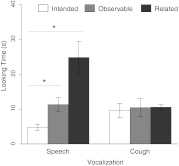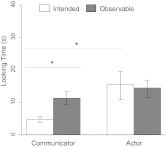Twelve-month-old infants recognize that speech can communicate unobservable intentions - PubMed (original) (raw)
Comparative Study
. 2012 Aug 7;109(32):12933-7.
doi: 10.1073/pnas.1121057109. Epub 2012 Jul 23.
Affiliations
- PMID: 22826217
- PMCID: PMC3420163
- DOI: 10.1073/pnas.1121057109
Comparative Study
Twelve-month-old infants recognize that speech can communicate unobservable intentions
Athena Vouloumanos et al. Proc Natl Acad Sci U S A. 2012.
Abstract
Much of our knowledge is acquired not from direct experience but through the speech of others. Speech allows rapid and efficient transfer of information that is otherwise not directly observable. Do infants recognize that speech, even if unfamiliar, can communicate about an important aspect of the world that cannot be directly observed: a person's intentions? Twelve-month-olds saw a person (the Communicator) attempt but fail to achieve a target action (stacking a ring on a funnel). The Communicator subsequently directed either speech or a nonspeech vocalization to another person (the Recipient) who had not observed the attempts. The Recipient either successfully stacked the ring (Intended outcome), attempted but failed to stack the ring (Observable outcome), or performed a different stacking action (Related outcome). Infants recognized that speech could communicate about unobservable intentions, looking longer at Observable and Related outcomes than the Intended outcome when the Communicator used speech. However, when the Communicator used nonspeech, infants looked equally at the three outcomes. Thus, for 12-month-olds, speech can transfer information about unobservable aspects of the world such as internal mental states, which provides preverbal infants with a tool for acquiring information beyond their immediate experience.
Conflict of interest statement
The authors declare no conflict of interest.
Figures
Fig. 1.
Procedure. During Familiarization trials (Upper Left), the Communicator attempted but failed to stack a ring on a funnel that already held a ring. During the Pretest trial (Upper Center), the Recipient interacted neutrally with all objects. In the Test trial (Upper Right), the Communicator vocalized, either speech or a cough, then the Recipient either performed the Intended (Lower Left), Observable (Lower Center), or Related (Lower Right) outcome.
Fig. 2.
Results. Mean looking times and SEM for the Intended (white bars), Observable (gray bars), and Related (black bars) outcomes for Speech (Left) and Cough (Right) vocalizations. *significance at P < 0.05.
Fig. 3.
Results of conditions ruling out the generic knowledge hypothesis. Shown are the mean looking times and SEM for the Intended (white bars) and Observable (gray bars) outcomes for the original conditions in which the Communicator both acted on the objects and spoke (Left) and the conditions in which the Actor acted on the objects and the Communicator subsequently spoke (Right). *significance at P < 0.05.
Similar articles
- Do 6-month-olds understand that speech can communicate?
Vouloumanos A, Martin A, Onishi KH. Vouloumanos A, et al. Dev Sci. 2014 Nov;17(6):872-9. doi: 10.1111/desc.12170. Epub 2014 May 19. Dev Sci. 2014. PMID: 24835877 - Understanding the abstract role of speech in communication at 12 months.
Martin A, Onishi KH, Vouloumanos A. Martin A, et al. Cognition. 2012 Apr;123(1):50-60. doi: 10.1016/j.cognition.2011.12.003. Epub 2011 Dec 30. Cognition. 2012. PMID: 22209584 - Voulez-vous jouer avec moi? Twelve-month-olds understand that foreign languages can communicate.
Vouloumanos A. Vouloumanos A. Cognition. 2018 Apr;173:87-92. doi: 10.1016/j.cognition.2018.01.002. Epub 2018 Jan 19. Cognition. 2018. PMID: 29358091 Free PMC article. - The developmental origins of naïve psychology in infancy.
Poulin-Dubois D, Brooker I, Chow V. Poulin-Dubois D, et al. Adv Child Dev Behav. 2009;37:55-104. doi: 10.1016/s0065-2407(09)03702-1. Adv Child Dev Behav. 2009. PMID: 19673160 Review. - Two sources of meaning in infant communication: preceding action contexts and act-accompanying characteristics.
Liszkowski U. Liszkowski U. Philos Trans R Soc Lond B Biol Sci. 2014 Sep 19;369(1651):20130294. doi: 10.1098/rstb.2013.0294. Philos Trans R Soc Lond B Biol Sci. 2014. PMID: 25092662 Free PMC article. Review.
Cited by
- Infants Produce Optimally Informative Points to Satisfy the Epistemic Needs of Their Communicative Partner.
Tauzin T, Call J, Gergely G. Tauzin T, et al. Open Mind (Camb). 2024 Oct 4;8:1228-1246. doi: 10.1162/opmi_a_00166. eCollection 2024. Open Mind (Camb). 2024. PMID: 39474157 Free PMC article. - Five-month-old infants detect affiliation in colaughter.
Vouloumanos A, Bryant GA. Vouloumanos A, et al. Sci Rep. 2019 Mar 11;9(1):4158. doi: 10.1038/s41598-019-38954-4. Sci Rep. 2019. PMID: 30858390 Free PMC article. - Listening to the calls of the wild: The role of experience in linking language and cognition in young infants.
Perszyk DR, Waxman SR. Perszyk DR, et al. Cognition. 2016 Aug;153:175-81. doi: 10.1016/j.cognition.2016.05.004. Epub 2016 May 19. Cognition. 2016. PMID: 27209387 Free PMC article. - Toddlers with Autism Spectrum Disorder Can Use Language to Update Their Expectations About the World.
Fitch A, Valadez A, Ganea PA, Carter AS, Kaldy Z. Fitch A, et al. J Autism Dev Disord. 2019 Feb;49(2):429-440. doi: 10.1007/s10803-018-3706-7. J Autism Dev Disord. 2019. PMID: 30136111 Free PMC article. - Twelve-month-old infants generalize novel signed labels, but not preferences across individuals.
Novack MA, Henderson AM, Woodward AL. Novack MA, et al. J Cogn Dev. 2014;15(4):539-550. doi: 10.1080/15248372.2013.782460. J Cogn Dev. 2014. PMID: 25364304 Free PMC article.
References
- Clark HH. Using Language. Cambridge, UK: Cambridge Univ Press; 1996.
- Searle JR. Speech Acts: An Essay in the Philosophy of Language. Cambridge, UK: Cambridge Univ Press; 1969.
- Sperber D, Wilson D. Relevance: Communication and Cognition. Oxford: Blackwell; 1986.
- Ganea PA, Harris PL. Not doing what you are told: Early perseverative errors in updating mental representations via language. Child Dev. 2010;81:457–463. - PubMed
Publication types
MeSH terms
LinkOut - more resources
Full Text Sources


